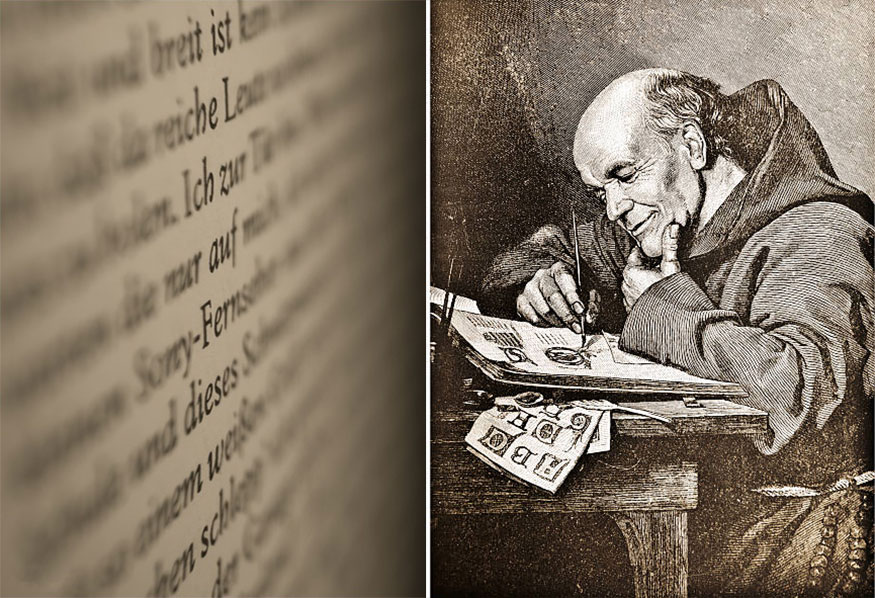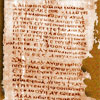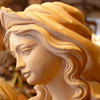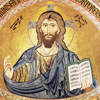Alteration Of The Gospels
 by Robert Charroux
by Robert Charroux
A considerable number of Gospels appeared in the first few centuries after Christ. The Church regards as canonical (in conformity with the rules of the Church) only those of Matthew, Mark, Luke, and John. The oldest of these is Matthew, which was directly inspired by the Gospel of the Hebrews.
One point must be stressed: The Apocrypha and the fifty or so Gospels that still exist, or existed before being destroyed by conspiracies, are unanimous in acknowledging that Jesus lived in the time of Pontius Pilate and Tiberius.
It has been said to be proved by the Acts of Pilate, a series of reports supposedly sent to Emperor Tiberius by Pontius Pilate, Procurator of Judea, containing an account of Jesus’s life and death, the crimes imputed to him by the Jews, his crucifixion, and even his resurrection. If these Acts ever existed, they must have been made out of whole cloth by Christians; in any case there is now no trace of them.
No Authentic Documents
Although the Gospels are consistent with one another concerning the time when Jesus live, there is less agreement on his acts and personality. Some Gospels attribute to him a doctrine and a frame of mind that are diametrically opposed to the accounts of Matthew, Mark, Luke, and John. Matthew and Luke are often in sharp disagreement with Mark and John, and sometimes contradict themselves. The vagueness and inconsistency of the four canonical Gospels explains why it was once forbidden for anyone but churchmen to read them.
Authentic documents have existed; there may still be some left in the Vatican Library. Dr. M. Spencer Lewis, Imperator of the Rosicrucians, has written that we know that the Fathers of the Church had access to secret documents because in the councils of the early Church there were references to parts of manuscripts and official documents dealing with the crucifixion and other events of Jesus’s life. These documents, says Dr. Lewis, are now either hidden or destroyed, and one of the main concerns of the Church Fathers between the seventh and twelfth centuries was to obtain manuscripts from collections in eastern countries which might contain information different from the version of the facts that had been officially accepted by the Church.
John the Apostle, who became Bishop of Ephesus, is said to be the author of the Fourth Gospel, but it is now acknowledged that this pseudo-Gospel was written later by clever theologians. It is certainly not by John himself.
A Hundred Gospels
Somewhere between fifty and a hundred Gospels appeared in the second and third centuries. Among the better known ones are the Gospels of the Hebrews, the Ebionites, Matthew, Mark, Luke, John, Thomas the Israelite, James the Minor, Nicodemus, Marcion, the Nativity of Mary and the Childhood of the Savior, the Childhood, the People, the Twelve Apostles, Bartholomew, Barnabas, Cerinthus, Peter, Basilides, Truth, Eve, Perfection, Philip, the Egyptians, the Gnostics of Egypt, Judas, Paul.
For the sake of unity, the Christian communities adopted the Gospels of Matthew, Mark, Luke, and John, and considered them as equally sacred and truthful, despite their gaps and contradictions.
The Gospels, being books “inspired” by the Holy Spirit, must not, in theory, be criticized, suspected, or disputed, but in our time this rule has been greatly softened. Theologians readily admit that the Gospels must be interpreted and even corrected, “in the right direction.”
To bring the different stories into agreement, the Church often modified or even rewrote the Scriptures. Tatian, a disciple of Justin, tried to solve the problem by writing the Diatessaron, a composite of the stories of Matthew, Mark, Luke, and John.
But how are we not to be disconcerted by the different genealogies of Jesus, according to whether we read Matthew or Luke? Matthew says that Jesus was the son of Joseph and descended from Jacob, Matthan, Eleazar, Eliud, Achim, Zadok, Azor, and so on back to David and Abraham. (Matthew 1: 1-16.) Luke also says that Jesus was the son of Joseph, but that he descended from Heli, Matthat, Levi, Melchi, Jannai, Joseph, Mattathiah, and so on back to Abraham, Shem, Noah, and Adam. (Luke 3: 23-28.)
Strangely enough, considering their basic divergences, Matthew, Mark, and Luke are called the “Synoptic Gospels” because of their supposedly close agreement with one another.
Saint Augustine Gives His Guarantee
We read in Saint Augustine, “It is not permissible to say or even to think that any of the Evangelists might have lied.” Furthermore, says the good saint, if we encounter seemingly contradictory statements (such as the two genealogies of Jesus), we must believe that they are actually in agreement, even if we do not see how this can be true.
John, whose story must be suspected, is in total disagreement with Matthew, Luke, and Mark concerning the chronology of Passion Week, and all four of them give different dates for Easter. According to John, Jesus was crucified not on Friday, but on Saturday, the day before Easter.
The divergences are even greater with regard to the resurrection, or, more exactly, the reappearance of Jesus. Matthew says that both Mary and Mary Magdalene were present; Luke and John say that only Mary Magdalene was there.
There is no acceptable evidence from the authenticity of the Gospels. The Church prudently presents them as the Gospels according to Matthew, Mark, Luke, and John.
In the second and third centuries, scholars and Doctors of the Church, such as Irenaeus, Clement of Alexandria, and the ardent Tertullian, believed that the Gospels had been written by the Apostles and that they were eyewitness accounts as well as being divinely inspired.
The Dubious Gospel of John
Polycarp, said to have been ordained Bishop of Smyrna by John the Evangelist in about the year 80, was the worthiest and most estimable of all the saints. Unlike the Apostles, who denied Jesus, he preferred death to the shame of denial. He was burned at the stake, but he was so effectively armored by his faith that he died without uttering a sound.
Polycarp is the author of a letter to the Philippians concerning the contested writings of Ignatius Theophorus (the first Saint Ignatius), who was falsely said to have been ordained by the Apostle Peter. Polycarp speaks of the first three Gospels, but not the fourth, because the Gospel of John did not exist at the beginning of the second century. It is mentioned for the first time by Theophilus of Antioch in about the year 180.
The Gospel of John is the most highly regarded, the most “initiatic,” according to the ignorant, the one that was written by “the eagle John,” who slept in the arms of Jesus and later, at Gethsemane, between Peter and James. Yet this Gospel is a notorious fraud perpetrated in the second century to make up for the lack of proper theological content in the other three. It is said to be a Gospel “not of facts, but of ideas.”
Some exegetists believe that the so-called Revelation of John, the last book of the New Testament, was written by Cerinthus. Cerinthus was a Jew by birth who believed in the obligatory Mosaic Law and in the future domination of the world by the Jewish people.
The Popes and Charlemagne Revise the Gospels
As my friend the writer Kronos reports in Essai de Meditations immaterielles, under Popes Gregory VII and Innocent III, the Church judged it wise to publish, for the use of priests, a highly modified summary of the Gospels, with reminders of daily rites and prayers. It was, and still is, the breviary.
It must also be stressed that translations of the Gospels were formerly forbidden, supposedly for fear of misinterpretations or mistranslations. It is hard to forgive these pious misgivings in view of the fact that councils, popes, and Christian sovereigns shamelessly altered the “Holy Scriptures,” including the translation done by Saint Jerome in the fourth century, that is, the Vulgate, which is the only one accredited by the Roman Catholic Church.
“The most radical alterations,” writes Kronos, “date from the Nicene Council and were motivated by the understanding between Pope Damasus I and Emperor Constantine. It was on this occasion that the oldest Gospels, notably the Gospel of the Hebrews (the original Gospel of Matthew) were declared to be ‘hidden’ (apokruphos = apocryphal).
“Furthermore, additions, omissions, and alterations were made in the four remaining Gospels. Saint Jerome, who had been commissioned to translate them into Latin, was surprised by this. He was all the more surprised because he had just translated the Gospel of the Hebrews into Latin, and he was now instructed to disregard it!
“Saint Victor, Bishop of Tumones (Africa) reports that at the end of the fifth century Pope Anastasius II again had the Holy Scriptures examined, criticized, expurgated, and amended. Charlemagne did the same, a few years before his death (Duchesne, Historiae Francor Scriptores), and he was imitated by Pope Sixtus V (1585-1590), who completed the work begun by his predecessors, to please Emperor Charles V. In this period the Church fabricated an Epistle of Saint Peter, later rejected by theologians. . . .
“Several thousand alterations were made. The Pope threatened terrible anathemas against anyone who might dare to tamper with the texts in the future, then he made a new revision which modified more than two hundred passages! A few years later, Pope Clement VIII (1592-1605) made more alterations, which fortunately were the last for printing had been invented.
(Note: Each bishop and each college had Gospels copied with varying degrees of accuracy, arranged to suit the copyist’s ideas, then revised by the bishop or the head of the college. The texts of the Archdiocese of Bordeaux were unlike those of the Archdiocese of Strasburg, those of Avignon differed from those of Cambrai. It was so easy to forget or falsify a text! But when printing with movable type was invented (in 1436), fraudulent changes became impossible and the Gospels had to be reproduced in conformity with an original.)
“Why all those alterations? It was quite simple: since most dogmas were inconsistent with the holy books, the holy books had to be made consistent with the dogmas!
“Between God and man there had to be Church to which man must submit beforehand, for otherwise he would not be allowed to have any contact with God. Christ had said, ‘God is everywhere,’ but this was dangerous pantheism! The Church could not run the risk of having man worship God in his creation. Only the Church transmitted God’s will. And ‘will’ in this sense is contrary to the free will that the creator gave us.”
Excerpt from Forgotten Worlds
Posted in Other Topics, True History of Manwith 1 comment.






WOW!!!